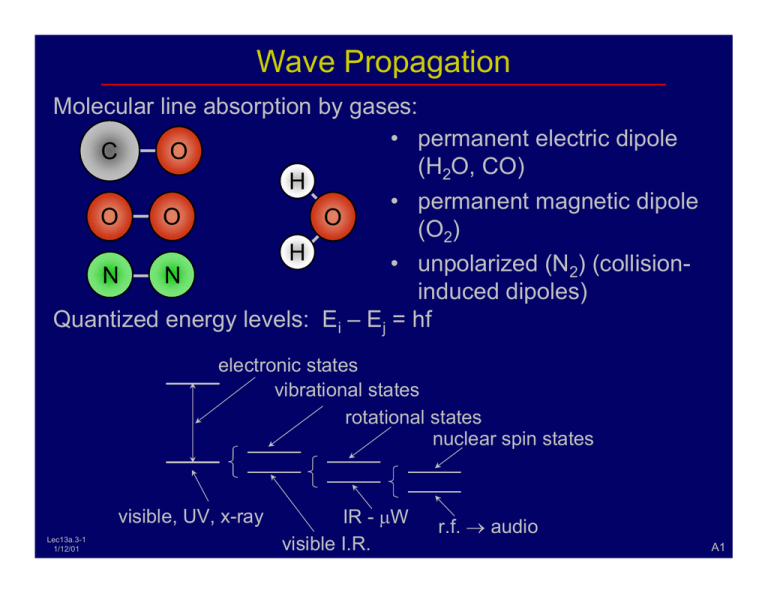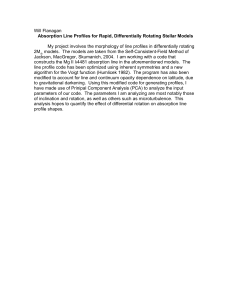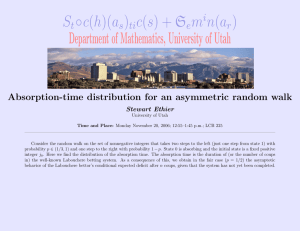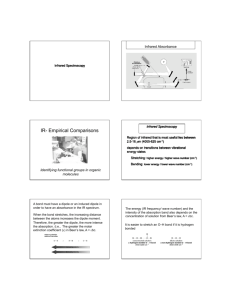Wave Propagation
advertisement

Wave Propagation Molecular line absorption by gases: • permanent electric dipole C O (H2O, CO) H • permanent magnetic dipole O O O (O2) H • unpolarized (N2) (collision­ N N induced dipoles) Quantized energy levels: Ei – Ej = hf electronic states vibrational states rotational states nuclear spin states visible, UV, x-ray Lec13a.3-1 1/12/01 IR - µW visible I.R. r.f. → audio A1 Molecular Lines in Gases Quantized energy levels: Ei – Ej = hf Probability of radiation = A + B ρf radiation intensity (energy density) “Einstein ‘A’ coeff.” “Einstein ‘B’ coeff.” Probability of absorption = Bρf A B = 8πhf 3 c 3 Atmospheric absorption of radio waves at zenith (clear air) dB 100 O2 Collisions and radiation compete to control level 10 populations. In equilibrium, kinetic and radiation 1 temperatures are equal. Lec13a.3-2 1/12/01 O2 H2 O H2 O 0 f (GHz) 22.235 60 118 183 A2 Molecular Line Shape Broadening: intrinsic, collisional, Doppler Einstein “A” yields spontaneous emission, limiting state lifetime T; intrinsic linewidth ≅ 1/T Absorption Electric field random collisions change dipole phase, orientation t f ∆ω = linewidth ∝ number of collisions/sec “Pressure broadening” or “collision broadening” ≅ 2 GHz at standard temperature and pressure (STP) for O2, H2O < 1 THz ( Lec13a.3-3 1/12/01 ) Doppler broadening has thermal 1 mv 2 ≅ 3 kT , 2 2 turbulent (random), and systematic components A3 Overlapping Spectral Lines Superposition characterizes the cumulative absorption by independent spectral lines, except for certain single molecules. For a single molecule with collision-coupled states, total absorption is generally greater than sum of line absorptions between coupled lines, and less outside. Such coupled lines coherently “interfere” (e.g. 60-GHz oxygen band). α(f) A+B interferenceenhanced absorption A alone B alone interferencereduced absorption α(f) 0 ωo f f Lec13a.3-4 1/12/01 A4 Refractive Effects ε(f) ε εo 1 fo α(f), resonance absorption The permittivity ε(f) of a medium is related in part to the absorption coefficient α(f) by the Hilbert transform; α(f) is related to the imaginary part of ε(f). f Atmospheric water vapor scale height = ~2 km Atmospheric density scale height ≅ ~8 km So humidity-based refractive effects are mostly a lower tropospheric ~ phenomenon (< 8 km). Thermal inhomogeneities are turbulent in the boundary layer (first few hundred meters or more) and near convective instabilities, and are more layered at higher altitudes. Lec13a.3-5 1/12/01 Humidity variations often dominate radio refraction, while density variations dominate optical propagation. Optical telescopes have ~1 arc-sec “seeing” on good nights (2” – 10” in Boston is typical); the best mountain days may yield ~0.4 arc sec., where “seeing” is the blur spot size, not absolute refraction. C1 Refractive Effects The radio index of refraction n is given by: (n − 1) 10 = ( 79 T ) (p + 4800 e T ) where T is °K, and p and e are total and partial water vapor pressures (mb). refraction less dense “duct” of humid air ionosphere dense dry humid over the horizon 6 Ducting can occur in cold or humid layers of air, or in under-ionized ionospheric layers. Acoustic ducting can occur in cool or salty ocean layers. Refractive seeing beyond the horizon can be ~ > 30 arc minutes on RF, and less at optical frequencies. Fading caused by interfering multipath: paths of different length cause different frequencies to cancel out or “fade.” Lec13a.3-6 1/12/01 C2 Ionospheric and Space Plasmas Plasmas can have both neutral and ionized components. ( ) The ionosphere has ne ≅ 107 − 1012 m−3 from ~50 to 5000 km altitude. Electron density ne (max) is ~100 - 400 km. Plasma frequency: ( ) ε = εo (1 − ωp2 ω2 ) neq2 −1 memi where m = rs ωp = ≅ me m εo me + mi q = electron charge Evanescent waves only, if ω < ωp Propagation delay: Lec13a.3-7 1/12/01 1 − ( ωp ω) > c 2 phase velocity vp = c group velocity v g = c 1 − ( ωp ω) < c 2 for f > fp v g vp = c 2 here ( ) C3 Refraction and Absorption by Plasmas Refraction by plasmas: ω > ωp ω < ωp θt refraction is governed by Snell’s Law sin θi sin θt = vpt vpi evanescent waves, total reflection Absorption by plasmas: Lec13a.3-8 1/12/01 y vp t z θi θi vp i transient electric dipole emits and absorbs # collisions ∝ n2e (weak in ionosphere) C4 Magnetized Plasmas Faraday rotation, bi-refringence x jK '' 0 ⎤ ⎡ K' ε = εo ⎢− jK '' K ' 0⎥⇒ ⎢ ⎥ 0 K o ⎥⎦ ⎢⎣ 0 y E x B -e z y The EM interaction and Faraday rotation become strong near the electron and ion cyclotron resonances, ωc = qBo m Lec13a.3-9 1/12/01 C5 Scattering and Absorption by Dielectric Spheres ε, sphere (e.g. raindrop) EM wave E D << D D > λo εo 2π ε λo 2π λo D >> 2π induced electric dipole ⇒ "Rayleigh scattering" ⇒ "Mie scattering" ⇒ Geometric scattering null dipole re-radiation pattern EM Mie is multimode: log (σs) induced electric dipole 4πa2 πa2 slope = 4 0.25πa2 Mie Lec13a.3-10 1/12/01 Rayleigh Geometric f C6 Scattering and Absorption by Dielectric Spheres Rayleigh regime ( λ >> 2πDε εo ) : (constant ε) ( ) (dBm ) ∝ f σs ∝ ( a λ ) λ scattering cross-section, α scattering dBm −1 σa ∝ ( a λ ) λ absorption cross-section, α absorption −1 6 2 3 ∝f 4 2 Cloud absorption < 85 GHz (Rayleigh region): [0.0122( 291− T )− 6] m • 10 γ CLD nepers cm ≅ 2 λ where m = g/m3 liquid water, λ = wavelength cm, T = K° ( strong scattering -1 ice ) Albedo < 0.8, fmax scat. ≈ 100 − 150 GHz ∴ TB > 70K as seen from space ∆ updraft (Albedo = reflectivity, all angles) cumulonimbus cloud rain Rain attenuation > 30dB sometimes Lec13a.3-11 1/12/01 C7







